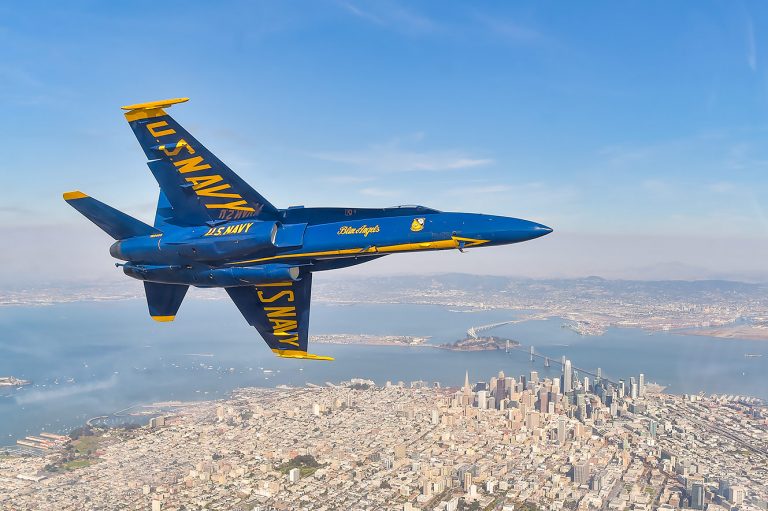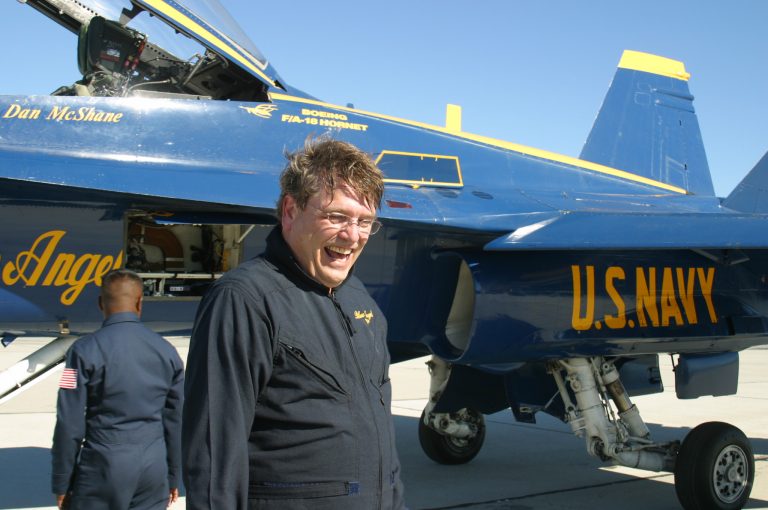
Flying With Angels
We taxied to the main runway at San Francisco International to our place in line behind a Lufthansa 747-400. Our F-18B Hornet was tiny compared to the Jumbo Airliner. To anyone watching, it must have looked like a mosquito annoying an elephant.
The pilot Major Nathan Miller wanted me to feel what it’s like to take off from an aircraft carrier. Once we were cleared to take off, he brought the plane to 85% power with the brakes fully engaged. The plane snarled and strained like a beast on a leash.
“Off brakes now.”
The plane shot forward at 500 feet per second. “20 knots, 30, 40… full afterburner,”
The plane climbed 20 feet off the runway and retracted the landing gear. We continued to gain speed “220…240… 260…. 280… Hit it.”
Major Miller pulled back the stick and the nose shot up. We climbed at a 45-degree angle to 3,000 feet in under two seconds, the full-throttle climb pushing me back into my seat as the F-18 ascended like a rocket. I remember grinning thinking this was as much fun as I hoped it would be.
KSFO was an official sponsor of San Francisco’s Fleet Week, the highlight of which was an airshow featuring the Blue Angels performing for millions over San Francisco Bay. To promote the show, the Navy gave three local reporters a chance to fly with the Blue Angels each year and as sponsors KSFO was guaranteed one of the slots. I always deferred to the on-air staff because I know they would give the Navy and Fleet Week the most publicity.
By October of 2007, the station had reduced its staff so much there was no one left who could, or would, take the flight, so I jumped at the opportunity. I had to take a physical and get the doctor’s approval to qualify. I barely made the weight limit, which I was told could be a problem.
“You’re a big guy,” the support team member said as he strapped me into the harness. “If you have to eject, make sure you stay compact or you could tear off an arm.”
The pilot followed with detailed instructions on how to unlock, arm and activate the ejection seat. I tried to follow along, but I doubted I’d ever have the awareness to remember the steps or the judgment to know when to take them. It was probably for the better. Our maneuvers would take place over the ocean near the Farallon Islands. If I did successfully eject it would be into shark-filled frigid water, most likely gushing blood from a missing limb.
In case I didn’t get the picture, Major Miller stressed, “if something happens out here we’ll be getting a ride back from the Coast Guard.”
It was a beautiful day and we had a 360-degree view of the San Francisco Bay Area out of the bubble canopy. On the right side I could see the coastal outline of Point Reyes. On my left was Santa Cruz with Monterey in the distance.
We started out easy with some quick rolls and climbs and dives. In the “wing-over” the pilot took the F-18 up at a 45-degree angle, lowered the left wing and dropped the nose into a turning dive. We hit negative “Gs” on the way down and turned momentarily weightless.
The climb combined with the roll was disorienting; the plane moved forward, sideways and up and down all at once; the view from the F-18’s bubble canopy spun from land to sea to land. The movement was like nothing I had experienced.
“It’s amazing,” I told Major Miller over the headset. “It’s like another world.”
I didn’t know at the time that I was being lulled into complacency.
“You ready for some anti-G-strain maneuvers?” the pilot asked.
Most fighter pilots wear pressurized suits with built-in air bladders that inflate and deflate to counter the gravitational forces experienced during high-performance aviation. The Angels fly with their right arms resting on their leg. If they wore flight suits, the pressurization would affect their control of the plane.
Instead, the pilots train themselves to overcome the effects of gravity by spending hours in the gym and in centrifuges. This conditioning is at the heart of their training and it’s ignored with dire consequences. A Blue Angel pilot crashed and died in 2007 because he made a turn too tight and blacked out.
We were taught exercises on the ground on how to force the blood and oxygen to keep flowing as the pressure tried to squeeze you dry. Major Nathan ran through it again in the air.
To keep the blood circulating, “tense your lower body; really dig your heals into the floorboard; give it everything you’ve got – quads, hams. calves, glutes… everything.”
And to keep the air passages open, he had me practice forcing air out of lungs in two quick burst saying the word “hook” with a big exhale on the K so it sounded like “hook-KAH.” When Major Miller said it, “hook-KAH sounded like a short one-two breathing exercise; mine sounded like a panicked cry for help.
Major Miller, proud of what he and his plane could do, launched us into a 360 loop. The G-forces pinned me to the back of my seat; one G is the force of gravity at sea level, so by the time we reached 7 Gs, my 220-pound body weighed over 1500 pounds.
The weight compressed my lungs and made every breath a struggle. The blood drained from my head and the edges of my vision began to fade. I knew I was passing out.
I realized I was holding my breath. Somehow I was able to suck in a small amount of air and my peripheral vision started to return. My “hooks” became grunts of survival “HOOO-KAAH…. HOOO-KAAH, I barked until my visions started to clear. ”
“Did we lose you there?” asked Major Miller.
“No I stayed here… barely,” I lied.
I was quickly back at full consciousness, but I felt like I had been body-slammed by a linebacker. My lungs ached and my legs were shaking from the strain… and this was just the beginning.
Fortunately the next few maneuvers were all done at zero Gs. Major Miller put the plane into a dive and started counting out the speed “600… 620…640. “Congratulations Ken, you’ve just broken the speed of sound. ”
I thought I felt a small shudder when we went supersonic, but it was probably my imagination. I couldn’t see the ground so I had no real sense of how fast we were going, but it was thrilling sitting in the back of F-18 traveling faster than a bullet.
The F-18 was designed to fly fast, but in combat, it was also important to go slow. Major Miller demonstrated its range of speed by almost standing the plane on its tail just above the water. He called it a dolphin maneuver. The drag sent shudders through the aircraft as we slowed from the speed of sound to under 125 knots in seconds.
The speed dropped so fast it triggered the anti-stall alarm. “WARNING… WARNING…”
Outside the plane’s drag was so severe it created its own weather as the wings churned up a cloud of fog. The plane bucked and resisted, but it stayed in the air.
The next move was a vertical roll. Major Miller rolled his plane on its axis while climbing almost straight up. We hit 7+ Gs for about 5 seconds; my breathing was better and my “hooks” were more controlled. I was starting to think I might make it.
I was sore and sweaty and ready to go home when Major Miller said “we’ve hit the graduation exercise, my friend. .. 7 and one-half Gs for 20 seconds or so.” Major Miller said. “How do you feel about that?”
“Eee,” I replied, trying my best to convey it was perfectly fine with skipping the last maneuver .
Major Miller ignored my hints and started explaining the minimum radius turn. It was designed to show the capabilities of the F-18. He hit the afterburners; rolled the plane onto its left wing and pulled the stick all the way back turning the plane parallel to the ground as fast and as tight as it would go.
I gave it everything I had; I tightened my legs and screamed hook with every last ounce of my will. The centrifugal force drained the blood out of my head and into my extremities. I struggled but 11 seconds into the maneuver my neck muscles gave out, my chin dropped to my chest and my vision went black.
I could hear Major Miller asking if I was okay, but I didn’t have enough wind to respond. He must have eased off on the turn because I could feel consciousness returning. Sometime during the ordeal the pressure stripped my eyeglasses off my face.
After a couple of breaths I was able to find my glasses and reassure Major Miller (and myself) that I was still alive.
“7.4 Gs, how did you like that?”
“Fine,” I said, “what I can remember of it.”
“You ready to go home?”
“Perfect,” I said.
I was sweating and breathing hard; my muscles were exhausted and I was bruised from bouncing around the cockpit. I was mostly able to relax and enjoy the flight back. I could see the entire Bay Area and it was fun to imagine thousands of people looking up and wishing they were where I was.
Major Miller had one more trick in his flight plan. He wanted a simulate a carrier landing, so instead of a long-slow glide to the runway like an airliner would do, we came in hot. Miller put the plane into a tight turn parallel to the ground to slow the aircraft. The pressure built to above 5Gs. I tried to do the “hook” exercise, but my muscles were spent and my will was gone. I gave up resisting and let my vision fade to black. Major Miller could see I was passed out and eased up on the controls. I regained consciousness in time to see him make a perfect landing at SFO.
My legs buckled so badly when I stepped out of the aircraft, I thought I was going to fall over. I was soaked in sweat, my hair was flying in all directions.
It was the feeling you get after suffering a trauma , a mixture of adrenaline, stress and fear so strong it leached from my pores. I was shaking so badly I had to sit down for a half-hour until I felt okay to drive.
I was proud of myself. I never threw up and only passed out twice. Better than most of the ride-a-longs, I was told. I’m always asked “did you have fun?” The answer is not really. It was thrilling, frightening and enlightening. I was proud to pass the test of endurance. Would I do it again? The answer is no. Once was enough.


I flew with the Blue Angels October 2, 2007 out of San Francisco International Airport
All I can say is “WOW”! What an experience!! My days at KGO Radio were truly a labor of love. Little did Mickey know that I loved my job so much ( Traffic, Broadcast Standards) that I would have done it for nothing! I had not one boring day in 34 years. Not many people can say that. If I were a writer, oh the stories I could tell. Maybe another time. Glad you survived the Blue Angels, Ken…….love ya!
Thanks for the kind words Verna. Good to hear from you.